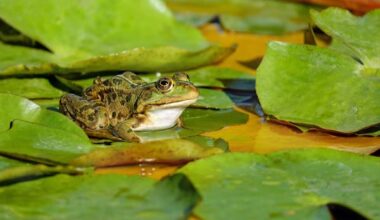Battling with stubborn pond muck can feel like an epic, never-ending saga. We’ve all been there – peering into our beautiful ponds only to be met with a layer of gooey gunk. But I’m delighted to tell you that the hero of this messy tale has arrived – the mighty Muck Eater!
The Muck Eater for ponds isn’t just about aesthetics though. It’s a champion for healthier ponds, working tirelessly to break down unwanted organic matter and reduce harmful nutrients. You’ll begin noticing clearer water and happier aquatic habitats after its divine intervention!
So let’s dive headfirst into how you can use this game-changing device to bid farewell to unruly sludge and hello to crystal clear waters once again. Join me as we embark on this journey towards cleaner, healthier ponds with none other than the trusty Muck Eater leading the charge!
Here is an exciting article you might be interested in my bell peppers are small
Another article for you my pepper plants are not growing

Identifying the Need for a Muck Eater in Ponds
Pond owners face numerous challenges when it comes to maintaining the cleanliness and health of their ponds.
One common issue is the buildup of muck, which is a combination of decaying organic matter, algae, and other debris that settles at the bottom.
This muck not only looks unappealing but also poses significant risks to aquatic life and water quality. To combat this problem, pond owners need an effective solution – enter the muck eater.
Selecting the Right Variety of Muck Eater
Not all muck eaters are created equal. Before investing in one, it’s crucial to understand your specific needs and consider factors such as pond size, depth, wildlife population, and existing vegetation.
Different types of muck eaters offer varying capabilities in terms of their ability to break down organic waste or consume algae. Doing thorough research will help you choose the most suitable option for your pond.
Muck Eaters’ Role in Maintaining Pond Health
Muck eaters serve a vital role in maintaining overall pond health by actively consuming excess nutrients like phosphorus and nitrogen present in decaying organic matter at the bottom.
By doing so, they prevent these nutrients from fueling excessive algal growth that can lead to oxygen depletion and harm fish and other aquatic organisms.
Installation Process and Best Practices for Muck Eaters
Installing a muck eater system involves careful planning and execution. Start by determining where exactly your pond has high concentrations of mucked areas or sludge build-up.
Then strategically place your chosen variety of muck eaters near these problematic zones for optimal efficiency.
Remember that proper maintenance is essential after installation as regular monitoring ensures that the muck eater is functioning effectively.
To that effect, regularly clean any clogged screens or intake pipes and remove accumulated debris from the system to prevent blockages.
Maintenance and Care of Muck Eating Systems
Like any other equipment, muck eaters require proper maintenance to ensure long-term performance.
This includes cleaning or replacing filters, inspecting pumps for debris accumulation, and checking for signs of wear and tear.
Additionally, it’s crucial to regularly test water quality parameters such as pH levels and dissolved oxygen content to assess the overall health of your pond.
Evaluating Efficiency: Signs that Your Muck Eater is Working Properly
It’s important to monitor your pond regularly to determine if your chosen muck eater system is working efficiently.
Key indicators include:
- A reduction in visible muck at the bottom of the pond
- Improved water clarity
- Reduced algae growth or blooms
- Healthier aquatic plants
- Increased oxygen levels.
Monitoring these factors will help you gauge whether adjustments are needed in your muck-eating system or if it requires professional assistance.
Challenges and Solutions in Using Muck Eaters for Ponds
Benefits of Integrating a Holistic Approach with a Muck Eater System
While muck eaters can significantly improve pond health by reducing organic waste build-up and controlling algae growth; it’s important not to rely solely on this technology as a miracle solution.
A holistic approach combines various strategies including regular maintenance practices like:
i. Skimming leaves off the surface before they sink into sediment layers at the bottom
ii. Using beneficial bacteria supplements which enhance biological activity responsible for breaking down organic matter
iii. Incorporating natural plant filtration systems like floating wetlands or submerged plants which regulate nutrient flow while providing habitat for beneficial organisms.

A Final Word
Selecting an appropriate variety of muck eater for ponds based on individual needs along with maintaining proper installation processes is crucial to maximize pond health.
Regular maintenance, monitoring, and evaluation will ensure the efficiency of your muck eater system.
By integrating a holistic approach with muck eaters, pond owners can enjoy clean water, increased biodiversity, and a thriving aquatic ecosystem for years to come.
If you found this article exciting, this is another great read: netting tomatoes
We also found this great pick for you: night time camp games
FAQs On Muck Eater For Ponds
Q: What is muck?
A: Muck refers to the accumulation of organic debris such as dead vegetation, fish waste, and sludge at the bottom of ponds or lakes.
Q: What is a muck reducer?
A: A muck reducer is a product designed to break down and eliminate muck from your pond or lake. It uses natural bacteria and enzymes to digest the organic matter.
Q: How does a muck reducer work?
A: A muck reducer works by introducing beneficial bacteria and enzymes into the water column. These microorganisms consume the organic matter, reducing muck accumulation and improving water clarity.
Q: How often should I use muck reducer pellets?
A: For best results, it is recommended to apply muck reducer pellets every two weeks. This regular application ensures that the bacteria and enzymes are continuously breaking down the muck.
Q: Can I use muck reducer pellets in a small pond?
A: Yes, muck reducer pellets can be used in ponds of all sizes, including small ponds. Whether you have a large acre pond or a small water garden, this product will effectively reduce muck.
Q: Is muck reducer safe for fish and other aquatic life?
A: Yes, muck reducer is safe for fish and other aquatic life. The natural bacteria and enzymes used in this product are non-toxic and do not harm fish or other organisms.
Q: How much muck reducer pellets should I use for my pond?
A: The recommended dosage of muck reducer pellets is 2 scoops per acre of pond. For smaller ponds, adjust the dosage accordingly.
Q: Can muck reducer also help with weed control?
A: While muck reducer primarily targets the decomposition of organic matter, it indirectly helps with weed control by improving water clarity. Clearer water inhibits weed growth and promotes a healthier ecosystem.
Q: Can I see the bottom of my pond after using this muck reducer?
A: Yes, using this muck reducer can help make the bottom of your pond more visible. As the product breaks down the muck and clarifies the water, you will be able to see the bottom more clearly.
Q: Are there any related products that customers have also viewed?
A: Yes, some related products that customers have also viewed include pond clarifiers, muck remover tablets, and algaecides. These products can be used in conjunction with muck reducer for complete pond management.


